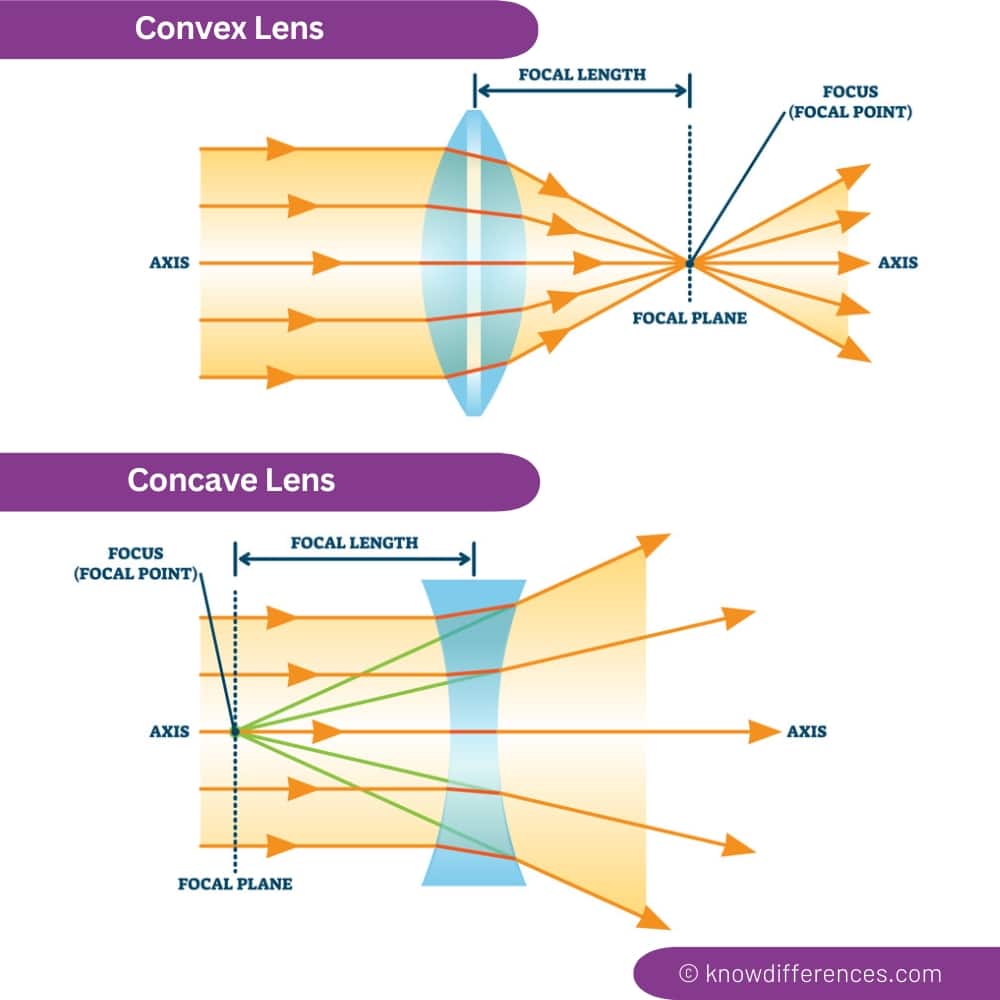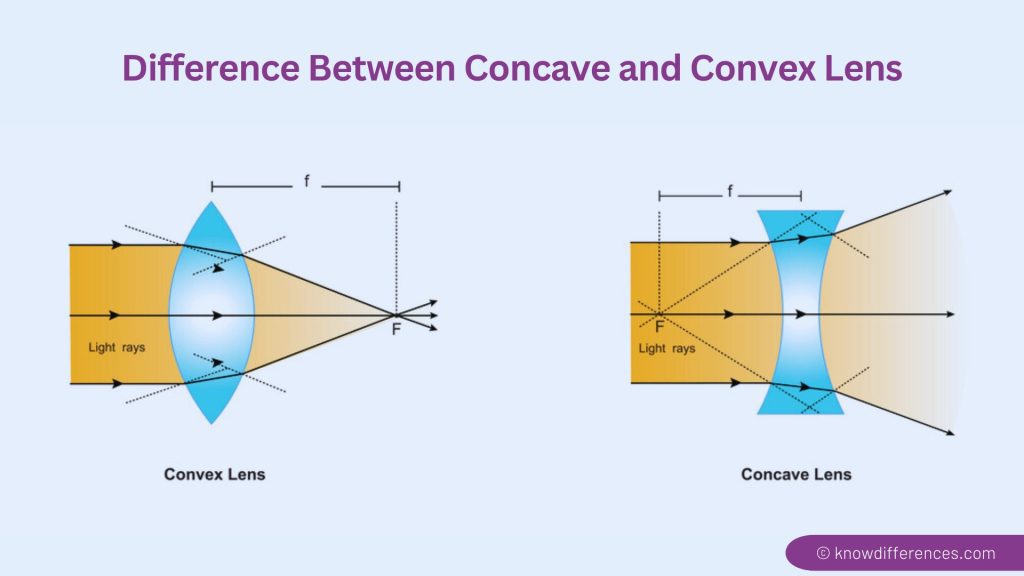In the realm of optics, lenses hold a significant place, enabling us to observe and manipulate light in various ways. Among the diverse types of lenses, two prominent ones stand out: the concave lens and the convex lens. These remarkable optical devices possess distinct characteristics and applications, creating a stark contrast in their functionality. In this article, we will delve into the intricacies of concave and convex lenses, deciphering their differences, properties, and real-world implementations. So, let us embark on this enlightening journey and unravel the secrets of these optical marvels.
Table of Contents
What are Lenses?
Lenses are transparent optical devices crafted from materials such as glass or plastic. They possess a curved surface that enables them to refract or bend light as it passes through. By manipulating the path of light, lenses facilitate the formation of images, allowing us to see objects clearly and in magnified or reduced forms. Concave and convex lenses are two primary types, each with its distinct structure and optical behavior.
How Do Lenses Work?
To understand the workings of concave and convex lenses, it is essential to grasp the concept of refraction. Refraction occurs when light transitions from one medium to another, causing its path to bend due to the change in speed. Lenses utilize this phenomenon by having one or both surfaces curved, which alters the direction of light rays passing through them. This bending effect enables the focusing or dispersing of light, leading to various optical outcomes.
What is Concave Lens?
A concave lens, also known as a diverging lens, possesses at least one inwardly curved surface. This inward curvature gives it a thinner center and thicker edges, resembling a hollowed-out shape.
Optical Properties
Concave lenses exhibit several unique optical properties. One such property is their ability to diverge or spread out light rays that pass through them. This divergence occurs due to the lens’s thinner center, which causes the light rays to refract away from the principal axis, resulting in a virtual focus point.
Light Ray Interaction
When light rays pass through a concave lens, they refract away from the lens’s principal axis. Unlike convex lenses, concave lenses do not converge the light to a single focal point. Instead, they create a virtual focal point from which the refracted light rays appear to diverge.
Applications
Concave lenses find numerous applications in different fields. One prominent usage is in correcting vision anomalies such as myopia or nearsightedness. By dispersing the incoming light, concave lenses help focus the image on the retina, allowing individuals with myopia to see distant objects more clearly. Additionally, concave lenses have applications in optical devices like microscopes, telescopes, and cameras, aiding in the magnification and analysis of minute details.
What is Convex Lens?
In contrast to concave lenses, convex lenses have at least one outwardly curved surface, resembling a thicker center and thinner edges. They are also known as converging lenses due to their ability to bring light rays together.
Optical Properties
Convex lenses possess unique optical properties that allow them to converge light rays. This convergence is a result of the lens’s thicker center, causing the refracted rays to bend toward the principal axis. Convex lenses also possess a focal point, where the converging rays meet.
Light Ray Interaction
As light passes through a convex lens, it refracts towards the principal axis, converging at a focal point. This focal point represents the point at which parallel light rays, traveling toward the lens, converge after refraction. The distance between the lens’s center and the focal point is known as the focal length.
Applications
Convex lenses find extensive applications in various domains. One of their primary uses is in correcting hyperopia or farsightedness. By converging incoming light, convex lenses assist in focusing the image directly onto the retina, enabling individuals with hyperopia to see nearby objects clearly. Moreover, convex lenses are employed in optical instruments like magnifying glasses, projectors, and eyepieces, where their converging properties are harnessed to enhance visual perception.

Concave vs Convex Lens: Comparison Table
Here’s a comparison table highlighting the possible differences between concave and convex lenses:
| Aspect | Intent | Concave Lens | Convex Lens |
|---|---|---|---|
| Shape | Appearance of lenses | Thinner at the center, thicker at edges | Thicker at the center, thinner at the edges |
| Focal Point | The point where parallel light rays appear to converge or diverge after passing through the lens | Virtual and negative | Real and positive |
| Image Formation | The process of forming an image by the refraction of light rays passing through the lens | Always forms virtual and diminished images | Can form both real and virtual images |
| Refractive Power | The ability of the lens to bend light rays | Negative | Positive |
| Diverging/Converging Effect | The effect of the lens on the direction of light rays | Diverging | Converging |
| Lens Function | The purpose or role of the lens in manipulating light rays | Spreads out light rays | Focuses light rays |
| Applications | Different practical uses of the lens in various fields | Correcting myopia (nearsightedness), camera viewfinders, telescopes | Correcting hypermetropia (farsightedness), magnifying glasses, projectors |
| Lens Type | Different types of lens designs | Biconcave, planoconcave | Biconvex, planoconvex |
Key Differences Between Concave and Convex Lenses:
Shape and Appearance
The most apparent distinction between concave and convex lenses lies in their shapes. Concave lenses possess an inward curvature, resembling a hollowed-out shape, while convex lenses exhibit an outward curvature, resembling a thicker center and thinner edges.
Focal Point and Focal Length
Another crucial difference lies in the focal point and focal length of the lenses. Concave lenses, being diverging, do not have a real focal point. Instead, they create a virtual focal point from which the refracted light rays appear to diverge. On the other hand, convex lenses have a real focal point, where the converging light rays meet after refraction. The distance between the lens’s center and the focal point is referred to as the focal length.
Convergence and Divergence of Light
Concave and convex lenses exhibit contrasting behaviors regarding the convergence and divergence of light. Concave lenses diverge or spread out light rays that pass through them, while convex lenses converge or bring light rays together at a focal point.
Magnification and Image Formation
When it comes to image formation, concave and convex lenses also display different characteristics. Concave lenses create virtual, reduced, and upright images. These images are formed when the diverging rays extend backward and appear to intersect. Conversely, convex lenses produce real, magnified, and inverted images. These images are formed when the converging rays meet and intersect in front of the lens.
Real-World Applications
Concave and convex lenses find numerous practical applications based on their optical properties. Concave lenses are commonly used in correcting myopia, as they disperse light and help focus images on the retina. They also play a vital role in optical instruments such as microscopes, telescopes, and cameras. On the other hand, convex lenses are frequently employed in correcting hyperopia and enhancing visual perception in devices like magnifying glasses, projectors, and eyepieces.
Recommended: Difference Between Concave And Convex Mirror
Conclusion:
In conclusion, the difference between concave and convex lenses make them invaluable assets in the world of optics. Concave lenses, with their diverging properties, find applications in correcting myopia and aiding magnification in optical devices. Meanwhile, convex lenses, with their converging abilities, are essential in correcting hyperopia and enhancing visual perception. Understanding the differences between these lenses not only expands our knowledge of optics but also provides insights into their diverse real-world applications. So, whether it’s exploring the microscopic world or enjoying a captivating movie projection, the distinct characteristics of concave and convex lenses continue to amaze and enrich our lives.
Frequently Asked Questions (FAQs)
What is the main difference between concave and convex lenses?
The main difference lies in their shape and the way they bend light. Concave lenses are thinner at the center and thicker at the edges, while convex lenses are thicker at the center and thinner at the edges.
How do concave and convex lenses affect the direction of light rays?
Concave lenses are diverging lenses that cause light rays to spread out. Convex lenses, on the other hand, are converging lenses that cause light rays to come together or focus.
What types of images do concave and convex lenses form?
Concave lenses always form virtual and diminished images. In contrast, convex lenses can form both real and virtual images, depending on the position of the object relative to the lens.
What are the applications of concave and convex lenses?
Concave lenses are commonly used in correcting myopia (nearsightedness), camera viewfinders, and telescopes. Convex lenses find applications in correcting hypermetropia (farsightedness), magnifying glasses, and projectors.
How do concave and convex lenses differ in terms of focal points?
Concave lenses have virtual and negative focal points, meaning the focal point is on the same side as the incident light. Convex lenses have real and positive focal points, where the focal point is on the opposite side of the incident light.
What is the refractive power of concave and convex lenses?
Concave lenses have negative refractive power, indicating their ability to diverge light rays. In contrast, convex lenses have positive refractive power, indicating their ability to converge light rays.

